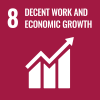San Jose, 28 July 2023 – "I arrived in the Dominican Republic knowing I owed USD 4,500. Still, I did not know the conditions under which I would have to repay it,” tells Andrea*, a young Colombian woman who left her country in search of better opportunities. “I soon discovered that all the money I earned was taken from me and that I was required to work long hours, from 8 AM to 3 AM the next day."
Andrea was grappling with her country's economic hardship and a lack of employment options. Amidst her desperation, a friend told her of a promising job opportunity in the Dominican Republic. The offer was tempting: a good salary and a significant loan from the company to cover her travel expenses.
Hoping to save money to support her family, Andrea agreed to the journey, without knowing her dreams would soon turn into her worst nightmare.
As soon as she landed, Andrea was taken by a group of men to a secret location where other women of various nationalities were held captive. Unable to repay her debt, she was forced into prostitution. Her so-called friend had deceived her into being sexually exploited by a transnational human trafficking network under horrendous conditions.
"They forced me to be with several clients, even during my menstruation,” Andrea recalls. “As a result, I experienced bleeding and had to seek medical help. I was told to cease sexual activities as I could develop ovarian cancer."
After eight months of profound despair, Andrea regained her freedom following a police operation. After returning to Colombia and reuniting with her family, she struggles to overcome the trauma from her ordeal.
Human trafficking disproportionately affects women. According to the Counter-Trafficking Data Collaborative (CTDC, 2023) statistics, nearly 80 per cent of the identified cases of human trafficking in the Americas involve women, and over 70 per cent of these cases result in sexual exploitation.

Maria was recruited by an international child pornography ring at the age of 12. Illustration: IOM 2023/Milena Somogyi
Victims of sexual exploitation are often transported to other countries, as in Andrea's case. However, traffickers can also commit these acts without physically restraining the person or taking them abroad.
María*, a young Costa Rican girl, was a victim of human trafficking at age 12 when a supposed representative from a prominent modeling agency contacted her via social media for a photo shoot.
“From a young age, I never had a passion for modeling, but I was attracted to photography, so I attended the casting, which seemed normal,” María says. “I went with my mother. The photos were casual. There were no bikinis or skin showing."
Due to their seemingly professional conduct, the agency representatives gained María's and her mother's trust. But everything changed within weeks. "One day, they told me I had to let them take nude photos of me and they threatened to kill or sexually abuse my younger sister if I refused," María remembers.
After three tumultuous years, María gathered the courage to confide in her mother about what was happening. They decided to change their address and phone numbers, close their social media accounts, and report the traffickers to the authorities, who eventually brought them to justice; they ended up in prison years later.
In the Americas, it is estimated that one in three victims of trafficking is a minor (CTDC, 2023). Although sexual exploitation remains the primary purpose, especially in Central America and the Caribbean, cases of labour exploitation are also a cause of concern across the region.

Tomás was a victim of labour exploitation in the United States after migrating irregularly to support his family financially. Illustration: IOM 2023/Milena Somogyi
Tomás, a 14-year-old Guatemalan boy, fell victim to labour exploitation in the United States. "No matter how much I worked in my country, it wasn't enough to cover my family's needs,” Tomás recalls. “So, when I heard from friends about a coyote offering the chance to go to the US to work and earn in dollars, it seemed like the solution I was seeking."
This young boy began his journey with other kids from Guatemala, El Salvador, and Mexico. They crossed the border with fake documents and finally arrived in California after days of traveling under inhuman conditions inside a truck.
"I lived under brutal conditions, working exhausting shifts between 9 to 12 hours daily, and received only a minimal amount of food. I slept, ate, and worked in the same place, with limited access to water to wash myself."
He and the other youths were forced to work growing tomatoes and other fruits in large agricultural fields. Every fortnight, they were paid USD 25, with the argument that the rest was meant to repay their travel debt.
One day, when Tomás was trying to send his meager income to his family in Guatemala, the employee at the wire-transfer office noticed he was extremely skinny. Tomás confessed that they had only received the morning food ration for the past two days and revealed that he was only 16 and from Guatemala. This revelation prompted the employee to report the situation to the police.
Thanks to this report, law enforcement managed to rescue Tomás, his friend José, and three other young boys aged 13 to 16 who were also being exploited for labour. They all showed signs of malnutrition and were in a state of emotional shock.
Worldwide, since 2002, there has been a growing number of male victims of human trafficking. In 2020, men accounted for approximately 20 per cent of the detected victims. However, the situation could be much more severe due to the underreporting of male trafficking victims identified in the few national studies.
The stories of Andrea, María, and Tomás reflect the brutal reality that millions worldwide endure. They are stripped of their dignity and freedom by ruthless criminals who only aim to profit from human suffering and exploitation.
These painful narratives underscore the urgent need for governments, civil society, and international organizations to enhance their strategies for prevention, identification, and support for survivors of this shameful crime. Only then will it be possible to fulfill our promise not to leave any trafficking victims behind in their right to justice and reparation.
*The names of victims were changed to protect their identities.
Text by Carlos Escobar, Communications and Media Assistant at RO San José.




